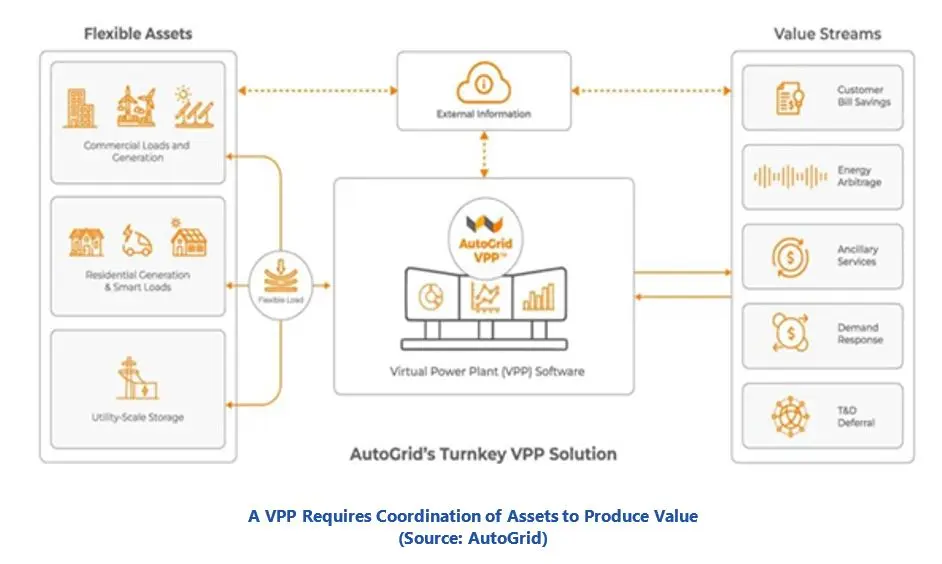

Keywords: VPP, Virtual Power Plant, Demand Response, Solar, Wind, Batteries, Micro grid, DERMS, ADMS, Renewable Energy, ARC Advisory Group.
The benefits of virtual power plants (VPP) can be significant. Odds are that in the US you may not yet have access to join a VPP. Driven by FERC order 2222, Grid operators have begun to create the rules that allow aggregators of distributed energy resources (DERs) to form virtual power plants. California Independent System Operator (CAISO), New York Independent System Operator (NYISO) and the PJM Interconnection have taken the early lead, but ERCOT is still pondering new policies to support VPPs.
A VPP is a large network of decentralized energy resources, managed by new software for grid operators, which can throttle back demand or export power to the grid. These resources may include electric loads like heat pumps, water heaters, or EV chargers. As an example, imagine that an aggregator has 10,000 EV chargers enrolled and a peak load event on the grid is happening, maybe on a hot summer evening. If the aggregator could command those EV chargers to postpone charging until there is ample or lower cost or cleaner supply, the grid load could drop by several hundred megawatts.
This has great value in improving grid stability. When a VPP can make such shifts in loads, the utility can share the financial benefits with each of the participating EV owners. In the Massachusetts town where I live, our utility will give EV owners a free WiFi controlled EV charger worth about $500 with the condition the utility will reduce the EV charge rate during peak load events. The homeowner can override this if they really need to charge at a high rate. The utility estimated that an average participating EV owner that comes home from work and plugs in at 5 or 6 pm will save the utility about $625 per year by reductions in peak loads. As most EVs can easily recharge overnight the homeowner is not inconvenienced. The utility recovers the cost of the free charger in less than a year.
Simply reducing load is only one of several ways a VPP can provide value. A VPP may include generation sources like solar panels, wind turbines, and batteries, and when these are aggregated the VPP can control these as if they were a single, large power plant. They can perform valuable grid services by reducing power demand, improving power factor, shifting loads, or injecting renewable battery power into the grid. Valuable services can include frequency regulation, voltage support, demand response, and energy storage.
VPPs can help to improve grid reliability, increase the integration of renewable energy, and reduce the cost of electricity. Since VPPs squeeze more value out of assets paid for by individuals, businesses, or institutions, they are cost effective replacement for the fossil fuel peaker plants that are often called upon today to fill in gaps when the sun doesn't shine, or there is no wind. As a result, VPPs are becoming increasingly popular, and they are expected to play a major role in the future of the electricity grid.
Grid operators must always have a reserve of transmission capacity and generation capacity to allow a margin of operational flexibility to meet unexpected loads, generation, or equipment failures. To ensure such capacity exists, they charge a tariff to all grid customers that is typically based on how much power your utility distribution system was using during the regional peak hour of each month. In my town we pay about 8 cents per kWh for electrical energy, but we pay about 5 cents per kWh in tariffs to support transmission and generation capacity of the regional system to meet peak demands. In New England, for example, summer peaks occur on extremely hot days due to AC loads.
With a new emphasis on switching to electric heating to reduce emissions contributing to climate change, winter peaks on frigid days may soon exceed the summer peaks. By reducing loads during these peaks our utility can reduce the transmission and capacity tariffs and we see many utilities installing grid scale batteries and expanding DER programs for this purpose.

Setting up a VPP is a complex process with many business and technical obstacles. The grid operator must first create rules and tariffs that would allow for energy trading to be attractive to the VPP. VPP providers can be utilities, unregulated arms of utilities, energy-as-a-service providers or even community choice aggregation (CCA) entities. VPPs must find many participants with flexible assets and bid into the grid markets with the confidence they can perform specific grid services. This is a dynamic activity, as new participants may join the aggregator gradually.
ARC Advisory Group clients can view the complete report at the ARC Client Portal.
Please Contact Us if you would like to speak with the author.
Obtain more ARC In-depth Research at Market Analysis

